Last updated on January 23, 2024
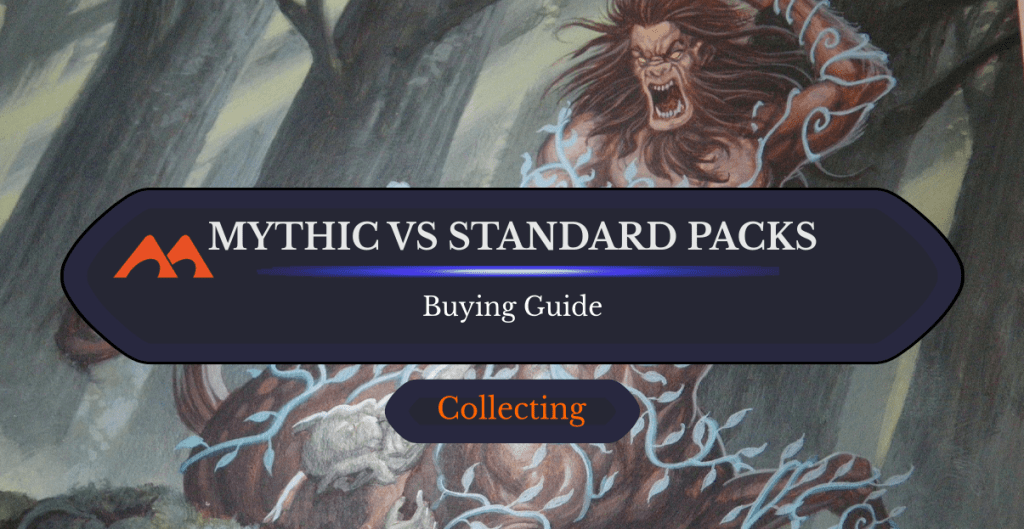
Mythic Proportions | Illustration by Jim Nelson
MTG Arena players will always complain about the game’s economy, and most of the time rightfully so. Whether you’re free-to-play or a cash spender, there’s always something to fix. With the introduction of mythic packs in the store, WotC attempts to solve an old problem in the client, by offering a slightly more expensive booster that comes with a guaranteed mythic rare.
But is it a good booster to buy, and does it really solve the problem? Are MTG Arena’s economy issues finally solved?
Let’s find out in today’s article, shall we?
The Difference Between Mythic and Regular Packs
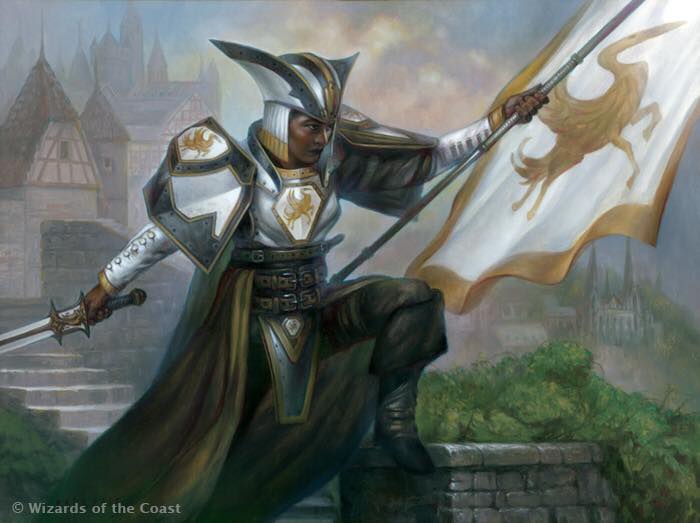
Thraben Standard Bearer | Illustration by Volkan Baga
When we open a mythic pack on MTG Arena, we’re guaranteed to hit a mythic rare card. That’s in opposition to a standard pack, which has about 85% chance of having a normal rare card and 15% chance of having a mythic card. Mythic packs cost a bit more though, and we’re talking about a 30% increase. You can buy them for 1300 gold or 260 gems, while you can get a standard pack for 1000 gold or 200 gems. While playing MTG Arena, all the pack rewards you’ll get will always be standard packs, so you can only get a mythic pack from the Arena store.
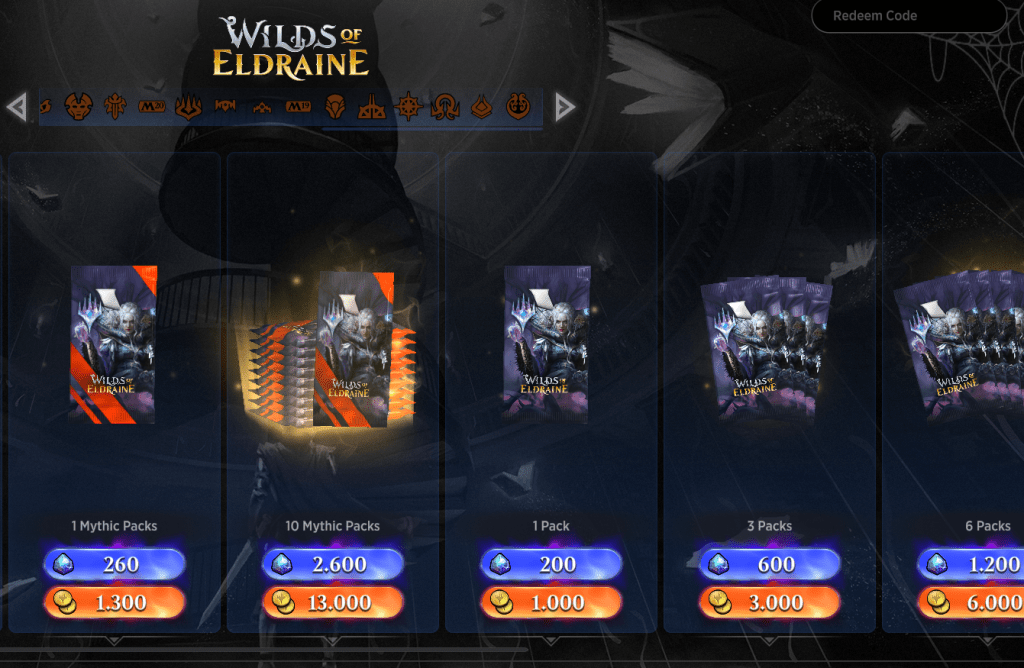
The thing is, for people that buy a lot of packs, or draft a lot on MTG Arena, it’s fairly easy to obtain all the rares in a given collection but at the same time lack several mythics. Once you have all the rares in a set, additional packs from that set will replace normal rares with 20 gems (40 for a mythic). WotC identified this issue and started offering mythic packs, so when you’re chasing a certain mythic from a set or going for 100% set completion, you’ll always get a mythic from these packs. If you’re lacking 10-15 mythics to complete your collection, you should go for the same amount of mythic packs on the Arena store. I use Arena Tutor to track my MTG Arena collection, and here are the results:
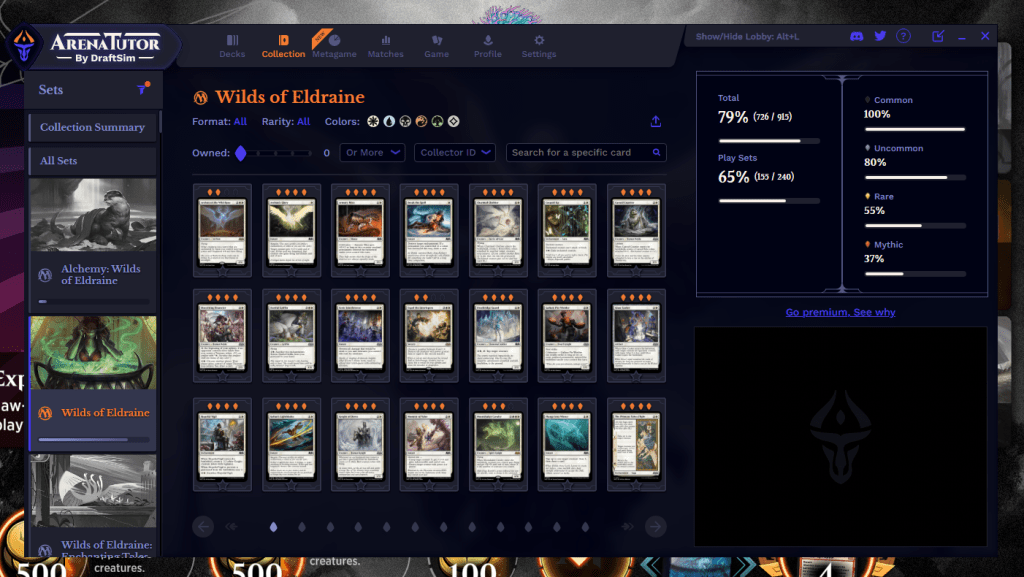
As we can see, for Wilds of Eldraine, I have 70% of the rares (around 140) and 30% of the mythic rares (around 24). In my case, I don’t think it’s interesting to snipe mythic packs, unless I was around 90%+ rare completion rate.
Mythic Pack Contents
Each mythic pack contains 8 cards: 5 commons, 2 uncommons and a mythic rare. You can’t get a regular rare card in your mythic pack. Sometimes, one of the common or uncommon cards will be replaced by its corresponding wildcard. Also, there’s a 1-in-30 chance that the mythic rare will be replaced by a mythic rare wildcard or a rare wildcard. Like standard packs, mythic packs are also duplicate protected, so you’ll never get a card you already have four copies of, and if you have all the mythics already, you’ll either get 40 gems or a rare/mythic rare wildcard.
Here are two packs I opened from my MTG Arena account, and as you can see, each pack has one mythic rare in it. Hey, I got the Ashiok I needed!
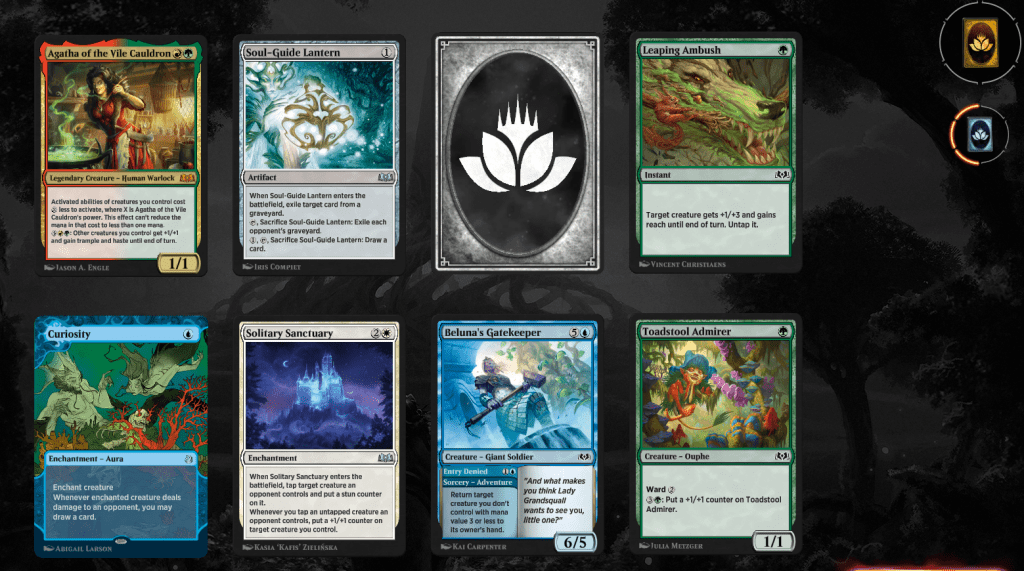
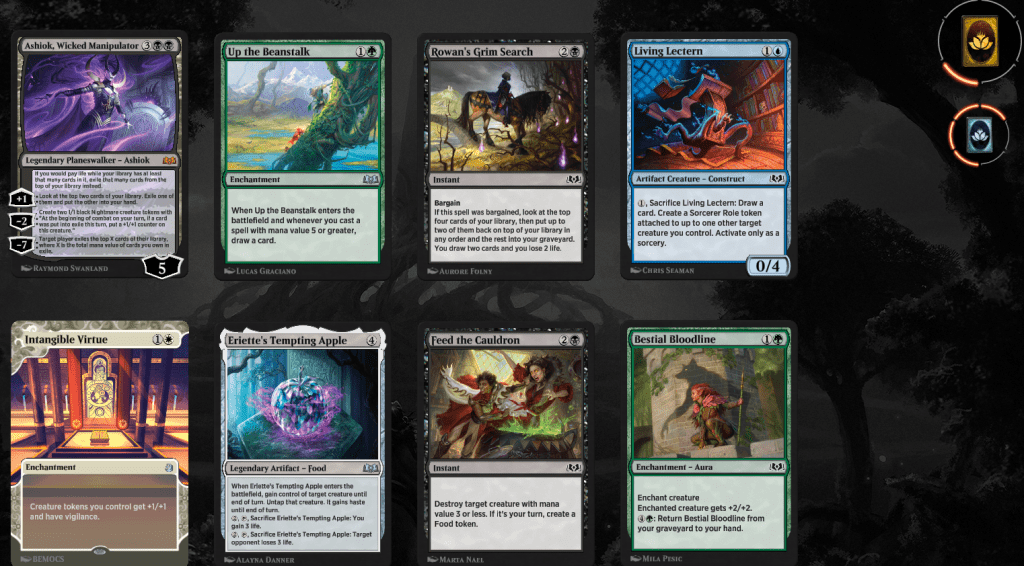
Are There Any Mythic-Pack Exclusive Cards?
No. Exclusive cards are usually bundled with MTG Arena bundles and deals, and you can always craft them by spending the corresponding wildcard.
Standard Pack Contents
Standard Packs contain 8 cards: 5 commons, 2 uncommons and a rare card. 1-in-8 standard packs will contain a mythic rare card instead of a regular rare, and there’s a chance that a card of each rarity is transformed into a corresponding wildcard. If you would open a rare when you four of every rare from that set, you’ll get 20 gems instead, or 40 gems for a mythic.
Which is Better? Mythic or Normal Packs?
On average, it’s better to get a guaranteed mythic than a rare, but for the price of 10 mythic Packs you can get 13 standard packs. We have to take this into account in our analysis, because you’re getting more contents in 13 normal packs. You’ll get more commons, uncommons, vault progression, and wildcard progression (remember that every seven packs you open will reward you with a rare or mythic rare wildcard).
Plus, it’s been a year since golden packs have been introduced to MTG Arena, and that changes the math a lot. I get a golden pack for every 10 boosters of the same set I purchase, and that’s three rares or mythics from that set plus three other rares/mythics from other sets. The golden pack progression alone makes it much more worthwhile to get standard packs instead of mythic packs. These charts show how different the contents from these packs are. We’ll compare what happens in three cases: when we spend 13k gold on both standard and mythic packs, and do the same for 39k and 70k. Here are the results:
Gold Spent = 13000
| # Packs | Commons | Uncommons | Rares | Mythics | Golden Packs | Wildcards | |
| Standard Pack | 13 | 65 | 26 | 12 | 2 | 1, 3 | 1, 9 |
| Mythic Pack | 10 | 50 | 20 | 0 | 10 | 1 | 1, 6 |
Gold Spent = 39000
| # Packs | Commons | Uncommons | Rares | Mythics | Golden Packs | Wildcards | |
| Standard Pack | 39 | 195 | 78 | 32 | 5 | 3, 9 | 6, 0 |
| Mythic Pack | 30 | 150 | 60 | 0 | 29 | 3, 0 | 5, 7 |
Gold Spent = 70000
| # Packs | Commons | Uncommons | Rares | Mythics | Golden Packs | Wildcards | |
| Standard Pack | 70 | 350 | 140 | 60 | 10 | 7, 0 | 11, 0 |
| Mythic Pack | 53, 8 | 269 | 107, 6 | 0 | 51 | 5, 4 | 10, 4 |
These numbers were calculated on average, so it’s possible but unlikely that you’ll open three standard packs and get two mythics and a mythic wild card. It’s more likely that you’ll get three rares in this situation. On the wildcards field I’m considering the conversion of opening seven packs and getting one wildcard, plus some wildcards that can be opened in mythic boosters. We can see that buying regular packs is better for your MTG Arena collection on all accounts, except the mythic rare cards. So, that means I should never invest in mythic boosters? Not quite. There are some scenarios where you’ll be tempted to get mythic boosters:
- If you have all the rares from a given set, there’s little value in opening regular boosters since you’ll probably get 20 gems. It’s very hard to draft a mythic rare since they don’t tend to get passed, and there’s only a small chance of opening them. This might sway you to purchase mythic boosters instead.
- You’re looking for specific mythics. There’s a 1 in 20 (5%) chance of opening it, so let’s say you want a copy of Ashiok, Wicked Manipulator and you’re out of mythic rare wildcards. Even if you don’t get Ashiok per se, you can still get a mythic wildcard.
- You’re mostly a Brawl or Historic Brawl player, and sometimes you’ll want one of each mythic from the latest collection. In this case, it’s better to go with mythic packs.
- Finally, if you have lots of rares and lots of rare wildcards, you should snipe those mythic packs.
What Happens if You Have All Mythic Cards and Open a Mythic Pack?
In this case, two things can happen. Since the mythic packs are duplicate protected, if you would open a mythic rare card, you’ll get 40 gems. There’s a chance that you’ll get a rare/mythic wildcard, and that doesn’t change with how many cards you have in your collection.
Best Mythic Packs
Here I’ll consider only Standard legal sets at the moment, with an honorable mention. Here are my nominees for best mythic packs:
Honorable Mention: Throne of Eldraine
It’s not legal in Standard, but Throne of Eldraine is one of the sets with the most juiced-up mythics, from ban-worthy cards like Oko, Thief of Crowns to staples like Embercleave and The Great Henge. Not to mention very good creatures like Brazen Borrower, Robber of the Rich and Questing Beast. You can’t go wrong buying mythic packs from Eldraine.
#5. The Brothers’ War
The Brothers’ War has the fewest staples from this list, but there are some good mythics all in all. White decks usually play Myrel, Shield of Argive, while black mages are probably well-acquainted with Gix, Yawgmoth Praetor and Phyrexian Fleshgorger, Control players might be interested in Urza, Lord Protector, Urza's Sylex, and Teferi, Temporal Pilgrim. Bladecoil Serpent sees some play in BRu midrange/value decks. One with the Multiverse and Cityscape Leveler are nice reanimation targets and appear in some lists alongside Atraxa, Grand Unifier.
#4. Kamigawa: Neon Dynasty
Kamigawa: Neon Dynasty has a surprisingly high number of playable mythics. Great picks include white’s staple card The Wandering Emperor, along with the other planeswalkers Kaito Shizuki and Tamiyo, Compleated Sage. Jin-Gitaxias, Progress Tyrant is a nice reanimation target. Some of the legendary dragons like Ao, the Dawn Sky and Atsushi, the Blazing Sky see play, while other mythics see niche play like Blade of the Oni, Tezzeret, Betrayer of Flesh and Kodama of the West Tree. Finally, Hidetsugu Consumes All sees some play in Explorer and Historic sideboards.
#3. Phyrexia: All Will Be One
We have lots of goodies in Phyrexia: All Will Be One. There’s Standard all-star Atraxa, Grand Unifier. There’s the Dominus cycle, which are five very powerful cards that can gain indestructible. We also have Phyrexian Vindicator and the reprint of Phyrexian Obliterator, which are good midrange beatsticks. The planeswalkers from this set are very good, mainly Vraska, Betrayal's Sting, Nissa, Ascended Animist, and Jace, the Perfected Mind. Elesh Norn, Mother of Machines rounds out the list as a beefy Panharmonicon-like legendary creature.
#2. Wilds of Eldraine
The first thing to note is that, right now, Wilds of Eldraine contributes to the golden pack progression, so there’s extra incentive to get these packs. The other is the mythics you can get. Beseech the Mirror and Ashiok, Wicked Manipulator are nice cards that see play in some decks, while Virtue of Loyalty and Virtue of Persistence offer good benefits early and late. Blossoming Tortoise offers value in ramp decks, while Agatha's Soul Cauldron can lead you to crazy graveyard builds. Not to mention the other mythics that haven’t had time to shine yet.
#1. March of the Machine
March of the Machine is number one because you’ll get a lot of playable mythics, from the legendary Praetor cycle to planeswalkers and battles. Best mythics from the set are Sheoldred, Elesh Norn, Chandra, Hope's Beacon, Wrenn and Realmbreaker, Monastery Mentor, Urabrask and Invasion of Tarkir. But even then, cards like Invasion of New Phyrexia, Archangel Elspeth, and Zurgo and Ojutai see play here and there, and the overall power level of the set is quite high.
Best Standard Packs
Considering all Standard legal sets, here are my nominees for best standard packs
#6. Innistrad: Crimson Vow
Like Midnight Hunt, getting VOW boosters means you’ll get a shot at five dual lands. We can also get strong cards for Standard like Wedding Announcement, Thalia, Guardian of Thraben, Hopeful Initiate and Hullbreaker Horror. Other interesting cards include Edgar Markov, Dig Up and Halana and Alena, Partners.
#5. Innistrad: Midnight Hunt
Midnight Hunt is filled with Standard staples, and it’s the set you should prioritize next. Not only do you get a shot at the other five dual lands, there are plenty of staples in this set. White gets cards like Adeline, Resplendent Cathar, Brutal Cathar and Fateful Absence, with other notable cards in Graveyard Trespasser, The Celestus, and Memory Deluge.
#4. Kamigawa: Neon Dynasty
Besides some cards that are currently banned in Standard, Kamigawa: Neon Dynasty offers a lot of value in cards like the legendary channel lands, the cycle of Marches and more. The enchantment deck in Standard draws heavily from this set’s rares like Kami of Transience and The Restoration of Eiganjo. We also have one of the most powerful sweepers in Farewell, and lots of good ninjas and sagas.
#3. March of the Machine
March of the Machine grants access to all battle cards, and some like Invasion of Tarkir and Invasion of Gobakhan are really good. Staples like Breach the Multiverse, Sunfall and Faerie Mastermind are also found here. Chrome Host Seedshark and Etali, Primal Conqueror are also excellent reasons to get these packs.
#2. Phyrexia: All Will Be One
Phyrexia: All Will Be One barely tops March of the Machine in Standard staples, mostly due to the fast lands, which see play in many formats. We’ve also got plenty of heavy hitters, like Phyrexian Arena, Glissa Sunslayer and The Eternal Wanderer (yes, planeswalkers at rare). Infect/Toxic decks will get all their tools here with the toxic creatures Skrelv, Defector Mite and Venerated Rotpriest, among others. The cycle of five Sun’s Twilights are also interesting tools to have at your disposal.
#1. Wilds of Eldraine
Following my previous logic, it’s very tempting to buy packs from previous sets in the hopes that we get the card we need. But with each Wilds of Eldraine pack, we’ll also get 1/10 of a golden pack, which can offer us six rares. These packs also have lots of goodies, including the creaturelands, nice faeries, adventure spells and more. I’d start getting Wilds of Eldraine packs until I have plenty of the rares from the set, and then go to the other ones in this list.
Wrap Up
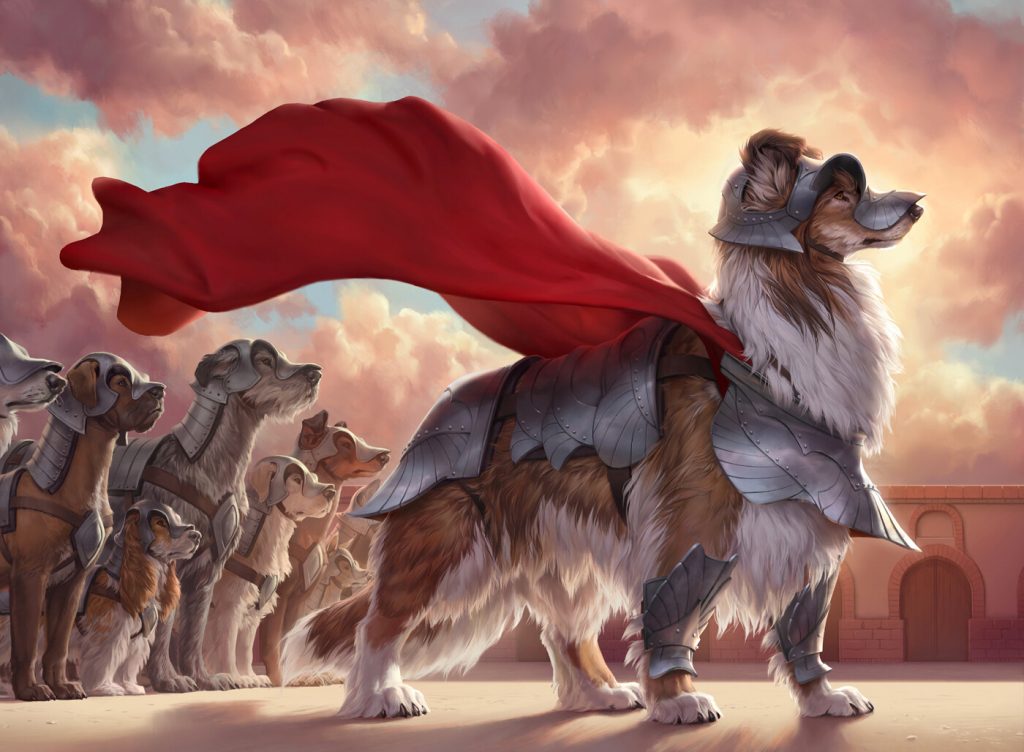
Pack Leader | Illustration by Ilse Gort
Mythic packs were introduced to MTG Arena to solve a problem the client had: the scarcity of mythics players would get even when buying a lot of standard packs. Since we can’t trade, craft or buy singles, even the bulk mythics of the set are hard to come buy. Most of the time, players were simply buying and opening packs in hopes of getting that mythic rare or that wildcard they needed.
They are currently a bad-value purchase though, and you should only prioritize getting them on Arena when your collection lacks mythics in a given set. If you want to track your MTG Arena collection, as well as getting draft pick suggestions and more, check out Arena Tutor. This way you’ll know exactly when to get those mythic packs. Did I get anything wrong, or do you find mythic packs to be good value? Please leave a comment below, thanks for reading my analysis folks, and I hope you liked it.
Follow Draftsim for awesome articles and set updates: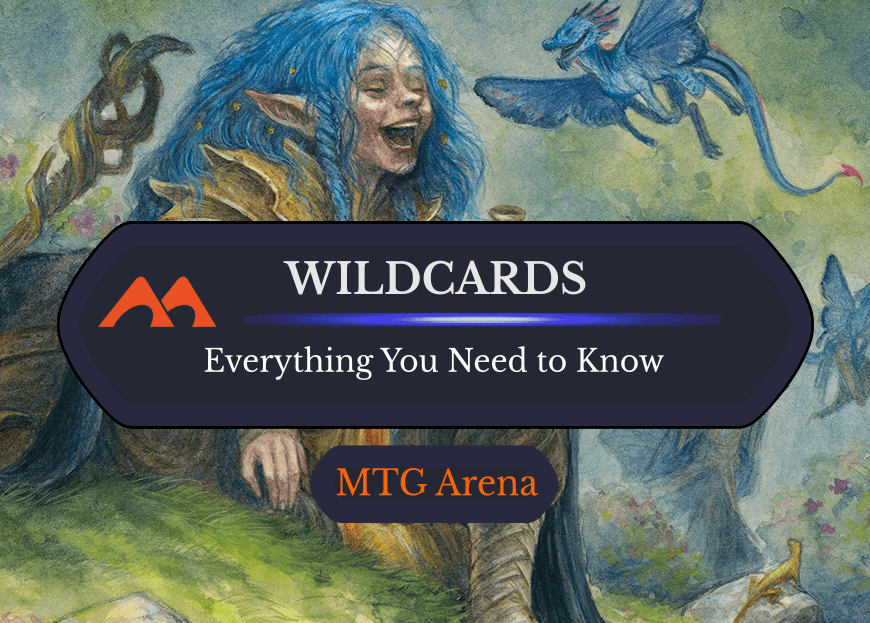

Add Comment